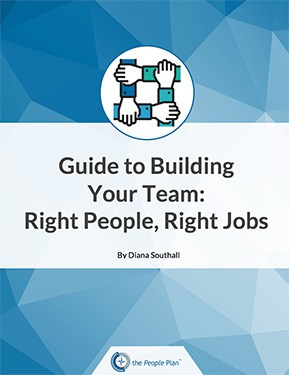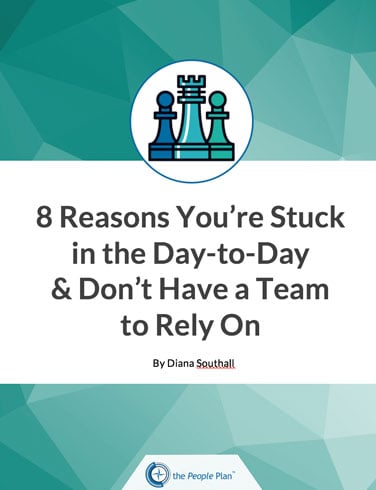
by thepeopleplan | Jul 24, 2013 | culture
Our prior article “What Drives Engagement?” listed the top 10 engagement drivers.
Two areas impact employee perceptions of their relationship with the supervisor (category 3):
1. Good relationship with supervisor
According to author James Robbins in his book “9 Minutes on Monday,” trust is the key component in a good relationship with your direct reports. He suggests a weekly “walkabout” to spend a few minutes talking informally with one team member to discuss something personal (not about work!) to show that you care.
2. Input into decision-making in my department
You don’t have to abdicate a decision to employees to get their input and improve their perceptions of “having a say.” Read our related post about “Total Reward #5 Autonomy” that shows a graph of the continuum of decision-making involvement
Three steps you can take NOW to improve employee perceptions of their relationship and role with (you) their direct manager:
- Schedule a time each week to do your “walkabout” to chat about the personal life of one employee.
- Find one moderately important decision you need to make soon, hold a meeting where you outline the issue and ask everyone to give input, discuss the ideas without “shooting them down” (you can share your thoughts and why you are considering this approach), and be sure to thank everyone for their contributions.
- After you have made the final decision, communicate this with your reasoning, again with recognition and appreciation for everyone’s input.
Article for more reading:
How to be a Better Boss in 2013 by leadership expert Jack Zenger (great tips here based on study of thousands of managers rated by their employees!)

by thepeopleplan | Jul 17, 2013 | culture, performance
Our prior article What Drives Engagement? listed the top 10 engagement drivers.
Two areas impact employee perceptions of what the organization values (category 2):
#1. “(My boss) sets high personal standards”
- Share what excellence and success looks like in their job (do you have any key performance indicators to discuss/ share/ track?)
- Hold everyone accountable to do their job to expectations (including yourself- walk the walk)
#2. “Organization encourages innovative thinking”
- Listen to new ideas and process suggestions, thoughtfully consider and discuss the viability of the idea
Three steps you can take NOW to improve employee perceptions of work standards and innovation:
- Regularly discuss work load and priorities, find out if team members have the tools and information to complete their tasks, and invite updates to re-direct if things aren’t on track
- Manage by results, not micromanage the process—this allows your team member to come up with a different (and often better) way to achieve the same outcome, then occasionally have staff share their methods with others doing the same task
- Ask your team- “What is one thing that could be improved for better customer service or to reduce a big hassle?” Then outline an action plan, assign tasks with deadlines, and revisit at your weekly meeting to implement this innovative improvement
Two articles for more reading:
It’s a fine line between setting high standards and being demanding. Read what NOT to do on Forbes: 10 tips on for dealing with an overly demanding boss
For tips on getting more practice at innovative thinking and turning into a habit, read “Innovation Is Everyone’s Job” on Harvard Business Review
Image courtesy of Stuart Miles at FreeDigitalPhotos.net

by thepeopleplan | Apr 16, 2013 | culture, job fit, performance
In a study by the Labor Relations Institute of NY, managers selected what they thought employees valued most, and then asked employees what they valued:
Manager /Employee rank- Job Reward
- 1/ 5- Good wages
- 2/ 4- Job security
- 3/ 8- Promotion and growth
- 4/ 9- Good working conditions
- 5/ 6- Interesting work
- 6/ 7- Personal loyalty to workers
- 7/10- Tactful discipline
- 8/ 1- Appreciation for work done
- 9/ 3- Sympathetic help with personal problems
- 10/2- Feeling “in” on things
You can see that the TOP 3 for employees were listed as the BOTTOM 3 in the eyes of managers. Hmm.. I wonder how much time and effort these managers put into these “bottom” rewards if they consider such each a low priority?
As a specialist in compensation, we regularly visit prospective clients who are convinced that their organization needs to pay more to attract, retain and motivate their team members. (And some of them do indeed have issues with pay below the market or internally inequitable.)
However, if your pay is fair for the work you expect and compared to others in your organization, one of the best investments you can make in building a terrific team is with recognition.
Recognition is practically free and creates an immediate impact such as:
- reinforcing company values
- aligning employee efforts to achieve organizational results
- appreciating specific employee efforts (then they continue to do these)
- modeling what ABC- attitudes, behaviors and contributions are valued (others start doing these)
- creating a positive work environment and culture (as more employees demonstrate the desired ABC’s and are recognized for them)
(Manager Survey Source: Foreman Facts, Labor Relations Institute of NY, 2004)
For a Quick recognition template view our 4/23 blog post
Image courtesy of watcharakun at FreeDigitalPhotos.net

by thepeopleplan | Aug 4, 2012 | culture, job fit, performance
I remember a Seinfeld episode where Jerry and Kramer pretended to be a traditional couple “How was your day, dear?”
Yes, they mocked this but how important are the People experiences to your day at work?
If you had a “bad day” it is often because of the people experiences you had—you had to assuage a difficult customer, a subordinate made a poor decision or behaved badly, a team member did not complete his part of the project and you had to do more work, your supervisor or co-worker was grumpy or critical, or you had to deal with petty politics.
Your day to day experiences with customers, managers and your team and the climate and culture of the office can be motivational or sapping to your energy.
Our firm’s founder Dr Jerry Newman found that social interaction was a key indicator in job satisfaction and retaining good workers in his book My Secret Life on the McJob. In fact, he found that many teenagers stayed at their fast food job even after college graduation partly based on the great camaraderie they felt at work.
A recent Gallup poll found that if someone had a “best friend at work” they reported more positive perceptions of their job, including much higher ratings of recognition, development, co-worker reliability, job importance, and achievement factors.
McDonald’s is leveraging the importance of what they call “Friends & Family” to attract employees.
According to a recent article by our firm’s founder Dr. Jerry Newman and McDonald’s Executive Vice President and Chief Human Resources Officer Richard Floersch, McDonald’s actually has very high employee perceptions of their people experiences in their job.
Reward/ Percent Who Love This About McDonald’s:
- Culture 82%
- Teamwork 80%
- People I work with 78%
Image courtesy of samuiblue at FreeDigitalPhotos.net

by thepeopleplan | Jul 12, 2012 | Uncategorized
Organizational effectiveness scholar Edward Lawler identified four “high involvement” principles that have a positive impact on employee engagement– power, information, knowledge and rewards.
What Lawler called “Power” (also referred to as autonomy or independence) means that employees have the power to make decisions that are important to their performance and to the quality of their working lives. Power can mean a relatively low level of influence, as in providing input into decisions made by others or it can mean having final authority and accountability for decisions and their outcomes. Involvement is maximized when the highest possible level of power is pushed down to the employees that have to carry out the decisions
Read more about Lawler’s principles for a high involvement workplace
Image courtesy of KROMKRATHOG at FreeDigitalPhotos.net








